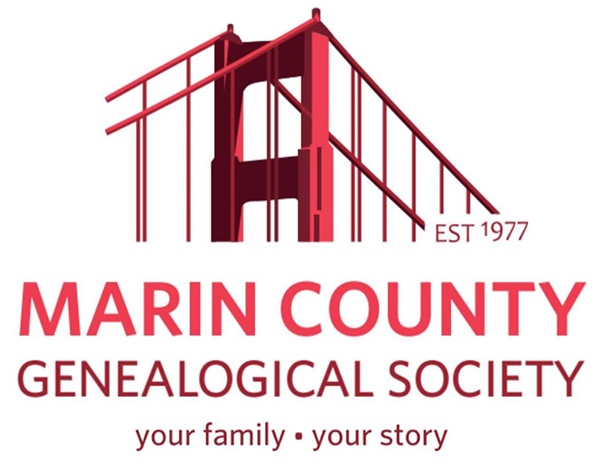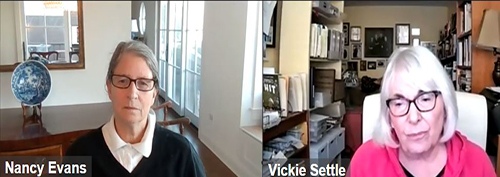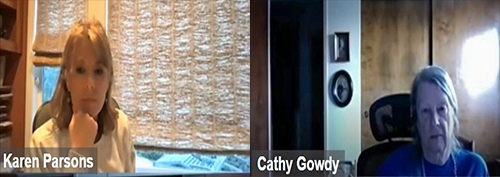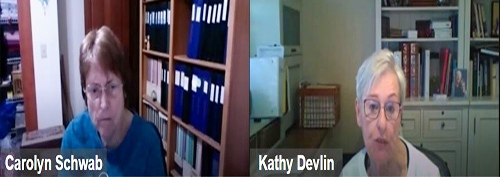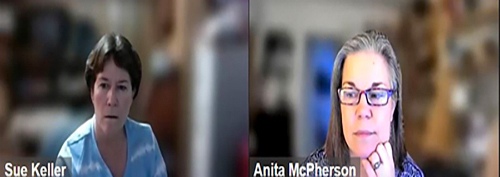Meet a Few of the Heroes behind the Marin County Genealogical Society
Recently, I was delighted to be invited to join the weekly meeting held by Marin County Genealogical Society (https://www.maringensoc.org/) (MCGS) to learn about this organization and topics related to genealogy. Nancy Evans (NE), Karen Parsons (KP), Anita McPherson (AM), Sue Keller (SK), Kathy Devlin (KD), Carolyn Schwab (CS), Cathy Gowdy (CG), and Vickie Settle (VS) participated in the meeting. This was a very informative conversation and I learned a great deal about genealogy from the participants and how it has evolved over time in terms of research methods and techniques. I learned about these ladies’ decades of dedication and hard work transcribing Marin County records such as birth, death, and marriage records, and then maintaining an archive of the transcriptions, which are of tremendous genealogical value. Because of their efforts, people can research their own family trees through the MCGS website in conjunction with other online services such as Ancestry.com.
A few months ago, a local newspaper, the Marin Independent Journal (Marin IJ) wrote a story about the MCGS current task of digitizing its paper records and making them available to the public. (https://www.marinij.com/2021/12/18/moving-marin-family-history-into-the-digital-age/.)
Following is the summary of the Q&As presented in the meeting. The answers will be marked with each speaker’s initials at the beginning.
Q: What is the mission of the Marin County Genealogical Society and how can people join?
NE: The mission of the MCGS is stated on the website as follows:
– Promote interest in family history through education and sound research methods
– Encourage stewardship of genealogical holdings
– Provide a forum to share genealogical information
Currently, we have 140 members and during the COVID period, we added new members from other states and countries because our meetings have been held online via ZOOM, which has broadened our audience. MCGS is open to everyone, and some benefits of joining MCGS are listed on our web site at https://www.maringensoc.org/page-1828496.
Q: What is genealogy and how has it evolved over time? Specifically, how was genealogy done before computers?
CS: Before computers, we did everything by hand. CG and I traveled around the United States looking for records, tombstones, etc.
CG: At that time, the mailman was my best friend because I would write letters to county recorders, members of historical societies, as well as ask relatives who were still alive. As a genealogist, we tend to write down stories from our parents, aunts, and uncles. Sometimes stories varied from person to person. Write down those stories! As for records from libraries, I actually got an intra-library loan from the Family History Library in Salt Lake City and viewed the microfilm in the library in Mill Valley, CA.
KD: We used to go to the National Archives (NARA) in San Bruno, the Sutro Library in San Francisco, and the Family History Library in Salt Lake City, and Oakland, CA, where there are large collections of film and book resources. Some libraries use the Soundex system that allows patrons to search collections via a surname.
As to your question about what genealogy is – genealogy is about building a family tree record going back as far as possible. However, for us, genealogy is not just about building a tree, it’s about building a family history. We enjoy studying our family through the lens of historical events and social and cultural history as much as family statistics.
CG: It is more than the history of the individual; it is also the history of the town, county, and state where the person lives because those larger events affect our individual ancestors’ lives.
NE: About 20 years ago, I was the Records Chair at a historical society in Massachusetts. In the early days, many people immigrated to the US through towns in Massachusetts. The historical society there receives many inquiries and I was the one who made copies and corresponded with inquirers back in the 1990s’. Later, that historical society bought an old barn and made it into a library holding all the records.
Q: How do you keep your records?
KD: Most of us have accumulated a lot of papers over the years. As technology has evolved, we have had to adapt our research methodology and record keeping. In my case, before the worldwide web was developed, c. 1985, my husband and I subscribed to CompuServe, a closed internet system primarily for the academic and science communities, and we got involved in the first chat groups. Members of CompuServe received a directory of all the people who were also in the system. When I was researching my relatives in Switzerland, I basically sent spam emails to everyone in the directory in Switzerland with my surname. I apologized for writing to them at work, and then went on quickly to genealogy questions. I received many lovely replies and some of those professionals are cousins and still my friends to this day.
Q: How did genealogy research evolve when computers were introduced, especially when Ancestry.com became available to the public?
VS: Back in 1987, I took a genealogy course from a junior college in Sonoma County and came back with a folder with an introduction on how to get information out of libraries. When I found something in the library, I would make a copy of it. Everything was on paper. Now, with computers, we have more choices, either make hard copies or store them on the computer.
SK: As an example, birth, death, and other records before 1906 in San Francisco are not available due to the earthquake and fire. So researching that information requires using a variety of now digitized records from surrounding communities and newspapers.
Q: How was the transition for you, personally, from papers to computers? Were there interim steps you needed to take to switch from paper to websites like Ancestry.com?
KD: Initially I kept binders, then I started using Family Tree Maker software along with the binders. Then the internet became available with unlimited resources. I was an early digital camera user and took photographs of the microfilm images when I went to Salt Lake, Utah. I spent many years digitizing some of the paper documents I have and adding them as sources to my family tree software. When Ancestry started offering more digital sources, there was not a way for me to add my personal source information images to their system. Now, we can add our sources and it becomes public so that other subscribers can use the data.
CS: I have 5-inch binders all over my place. I put my tree on Ancestry to share. I don’t have pictures but I put in sources. I could die any day so I thought it would be a good idea to move my research to Ancestry and out of my binders.
CG: I’ve got mine all in paper form. I put things in the tree that serve as proof for each generation. I don’t trust the internet enough to keep everything on the computer; I want the backup on paper. Things change, but I am still a paper person at heart. For safety sake, everyone should have a backup — it is very easy for the internet to go down.
VS: To me, the transition from all paper to computer is a challenge. I did not do genealogy for many years. When I came back to it, everything was online. I am now caught between what to keep and what not to keep and where to keep it. There is a process of evolution. Having to understand how computers work and how online works.
Q: How should people do their own genealogy, especially if they are new to genealogy?
NE: We have done many programs for beginners in our society. The basic is to start interviewing any living relative and start documenting the information on paper or in an online tree. Since you are working backward in time, you try to connect generations through time and through birth, marriage, and death records. Use these documents to track people in time and make sure you get the correct people and draw your own conclusions.
There is a huge change going on right now in genealogy research and that is DNA. I would do that immediately and get the DNA of the earliest generation possible in your family. If you share your DNA on Ancestry.com, the website will match your DNA with other people within the same website. For example, I have 34,000 matches on Ancestry. I won’t look at all the matches but I will look at hundreds and hundreds of them. In those matches, Ancestry will show how much DNA you share with the person. There is a number you get and those numbers mean something: a number like 2500 means you are probably looking at a sibling; 3500 means you are looking at parents or a child; 800 means a cousin; 50 means a third cousin. You start to get to know how close you are to one person by how much DNA you share with that person. There are many techniques to work with within the DNA database and a lot of numbers to look at.
AM: My father-in-law was adopted at birth in 1943. He did not know anything about his birth family. He did a DNA test and was finally able to identify his birth family. Since then, he met his first cousin and later his half-brother. In general, DNA tests have been primarily distributed in the United States. Then they got picked up in Northern Europe. A lot of countries have limitations. In France, for example, DNA sharing online is not legal. The laws are different in every country.
KD: Ancestry and 23andMe are the largest online collections of DNA data in the world, which yields huge databases of users that can be used not only for genealogy but also for epidemiology. Users are given the option of joining in health studies or study groups specific to places or surnames. The data is always stripped of personal identifiers.
NE: Our DNA data is protected. Every website has its terms and services. They vary by company. But you can give these companies permission to use it anonymously. For example, if I allow it, they might get a collection of Irish descendants and see we all have this kind of health problem. It is anonymous.
NE: For the last 10 years, it has evolved very fast how DNA is used. DNA is also used in solving crime.
**A recent article by Colin Woodard, entitled “The 11 Nations of America, as Told by DNA–North America was settled by what were, in effect, separate nations — and the proof may reach right into your DNA” highlights some scientific possibilities from the study of the DNA and can be found at this link: https://medium.com/s/balkanized-america/the-11-nations-of-america-as-told-by-dna-f283d4c58483
KD: Back to your earlier question about how people can begin doing their own genealogy: family group sheets can be one tool. They are still available on genealogy websites and they are a good tool to chart your immediate family, especially for beginners.
When people test their DNA at a genealogy site such as Ancestry, testers will receive online lists of other people who match their DNA. If people also post a family tree to, say, Ancestry, Ancestry will then send “hints” such as birth, death certificates, census records for test-takers.
VS: This is why we can spend hours and hours on Ancestry to do research.
NE: It is not just Ancestry. There are many other websites that would also have the records that allow you to build your own tree.
Many counties keep birth, death records. We, as researchers, have been collecting that information, either making copies from the counties’ records or visiting cemeteries in the county.
CG: For me as a researcher, I like to produce databases. I was involved in the very first of our genealogical society’s projects, which was the reading and recording of the tombstones in the cemeteries in our county.
Q: Please share with us your recent tasks in going digital which was featured by Marin IJ recently.
CG: A few people in MCGS have been digitizing my collection of obituaries in Marin County. We want to make them available on our society’s website. I have been collecting those obituaries for several decades. I have created an obituaries index on my computer. The first thing I do every morning is copy and paste obituaries from the Marin IJ. These are the databases stored on my computer and they are now being converted primarily for our society.
There are many things you can do when creating databases. I used to spend a lot of time at the Marin County Coroner’s office making copies of the earliest records and indexing them up to a certain date. I did not do anything beyond 1910. I also did the Undertakers’ records. Carolyn (CS) has collected newspapers and she would abstract all the marriages, births, deaths records, and anything that had genealogical value. She created books that have been published by our society. That was her big project.
For the early records, Carolyn and I would use the microfilms in the city libraries for our research.
KD: Currently we are scanning paper copies of Cathy’s research and converting them to searchable PDF files and posting them on our society’s website.
CG: Anybody can contact our society and ask for the research person who is in charge.
Q: What is the cost in terms of subscription to an online genealogy website and storing information on the web for a genealogy researcher?
KD: A subscription to an online genealogy website varies from free to hefty ($.00 to $400 annually). Most of us subscribe to multiple sites because the tools on one site may be better than another, or the digitized resources differ from one to the other. Some of us are better than others at taking advantage of discounts offered, or figuring out how to use the resources without actually subscribing!
A wonderful benefit of belonging to the MCGS, is access to not only our materials, but also to some of the subscription-only genealogical websites available at the Family History Center in San Rafael, where we have our own library collection. During COVID, our research library has been inaccessible, and we are looking forward to being able to resume our normal schedule.
NE: The MCGS aims to make genealogy resources available to members at no cost, such as providing webspace for our researchers’ work and the Index to those resources.
The index is free on our website, but if people want more information, they have to pay. Each data set has its date range.
We have published many books on genealogy and they can be found at this link: https://www.maringensoc.org/page-1828540
The Society also pays for speakers to educate our members. We also have lots of special interest groups (such as a genealogy book club, a writing club, a DNA study group, etc.), social hours, and mentor meetings. We try to do a lot to bring genealogists together. Since COVID, we have more groups than we used to.
Our partnership with the LDS church allows us to use their space for our meetings and to house our library collection.
Q: Digital formats change over time. It is harder for older digital documents to be read. Is it a concern for you as a genealogy researcher?
KD: Sure. The example we have been talking about of digitizing our collection is one such situation. The format is going from paper to PDF files now, but down the line technology will be different, and that will present new issues related to conversion to the newer technology. This is equally true for individuals and for librarians, who will continue to be challenged to figure out how to stay current and to protect the data. Some services that we subscribe to such as Family Search, Ancestry, and the like, will automatically keep the data updated to the newer formats.
NE: I don’t have any paper. All my family tree records are in digital format. I use a website called FamilySearch–the LDS church website. They have been collecting data all over the world for over 100 years. They store their papers and backups of all records in their mountain vault in Utah. This is what I am relying on — the (mountain) vault in Utah.
Q: How do you see genealogy in the future?
KD: Through developing technology, we can see where genealogy may go. It could be a Virtual Reality experience, where it will seem as if we are in a room with other people in terms of space and time. Wouldn’t it be cool to step into a historical site in England in the 1800s?
At MyHertiage.com (similar to Ancestry), you can upload a photograph and they will animate it for you. In the photo, the person will wink, or smile at you and turn their head. They also provide a feature where you can colorize a black and white photo. It is free for the first 8 images, and a subscriber has unlimited access to the tools.
NE: I think Family Search is doing something like this. Maybe it is not fully 3D virtual but they formed a new session at the LDS church in Utah.
*****
We thank the members of the MCGS for their dedication to preserving Marin County’s genealogical records, and for their thorough answers to our questions. If you have any genealogy-related questions, please visit their site or contact them directly at www.maringensoc.org.
